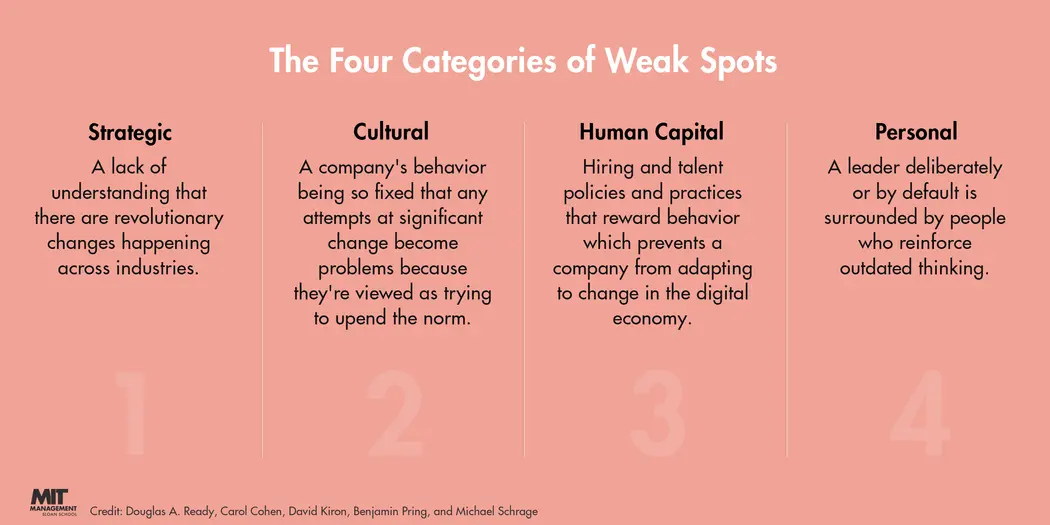Credit: Israel Vargas
Businesses are transforming, the nature of work is changing, and workforce values are evolving. And that was before the COVID-19 pandemic upended everything.
Amid this perfect storm of digital and cultural changes, leaders must set a tone of agility as well as experimentation if they want their organization and employees to succeed, according to MIT Sloan senior lecturer
A pandemic won’t be the last macro change to influence the economy, yet a global survey of more than 4,000 business executives revealed most aren’t confident that their leaders are ready to weather the next disruption, much less evolve for digital business. Only 9% of survey respondents felt their leaders had sufficient skills to be able to lead in the digital economy.
“It’s coming to the challenge with a sense of perspective and resiliency, of understanding that the world is more complex and hypercompetitive,” said Ready, who co-authored the survey and correlating report, and also teaches the MIT Sloan Executive Education course Reimagining Leadership: A Playbook for the Digital Economy.
“You can’t just mull around forever and create a 30-year plan,” Ready said. “Leaders need to be able to get a bead on what’s going on pretty quickly, and then also be able to empower their people and equip them so they can flourish and do their jobs.”
The strongest leaders in the digital economy understand and appreciate the fact that they live in an ecosystem world, said Carol Cohen, one of the survey co-authors and senior vice president of global talent and transformation at Cognizant, which sponsored the project.
“Your long-term success is not just determined by what you achieve alone,” Cohen said, “but also by how you empower, engage, support, and elevate your colleagues and teams in the ecosystem around you.”
Here’s a closer look at leadership mindsets, weak spots, and four recommendations to help leaders and their organizations embrace a successful strategy for the digital economy.
What is your company’s leadership mindset?
The survey collaborators asked respondents to consider what company characteristics would attract the best talent in the digital economy. Those traits largely fell into one of four mindsets:
- Producer — Organizations with this mindset are digitally savvy and operate with a sense of speed and urgency. Producers combine an emphasis on customers with a focus on analytics, execution, and outcome. They make disciplined decisions and get things done.
- Investor — Organizations with this mindset are focused on work that is purpose-driven. They also care about the planet and are mindful of sustainability.
- Connector — Organizations with this mindset are experts at relationships, partnerships, and networks. They understand we are living in a platform world and are part of an ecosystem, and they create a sense of belonging.
- Explorer — Organizations with this mindset promote an atmosphere where experimentation is the norm. They hire and retain people who are inherently curious, encourage input, and are not afraid to try, test, and repeat.
The researchers found that leaders who cultivated these signature mindsets were more likely to turn their companies into talent magnets.
“Top-flight talent in the digital economy crave this kind of work environment,” Ready said. “They aspire to work with colleagues who are part of a community of leaders who are customer-obsessed, digitally savvy, purpose-driven, relationship-minded, and joyfully resilient.”
Identifying gaps and avoiding ‘cultural inertia’
Labeling a leadership mindset is one step in becoming an effective leader in the digital economy. Another is to identify and address any weaknesses or gaps you might have when confronting challenges and change.
According to the authors there are four types of gaps:
Capability gaps include a lack of technical savviness, perspective, or the ability to understand the strategic implications of advanced technologies.
Leaders looking to close these gaps will understand and accept that there will be employees more digitally savvy than themselves, but instead of penalizing those people, they will push them in the direction of progress. These leaders should strive to make data-driven decisions, take risks, and lead by example.
“Part of being an authentic leader is knowing what you don’t know and accepting lessons from all directions,” Cohen said. “One great example is reverse mentoring. It is an acceptance, particularly with millennials, that they may be in better positions to teach you directly how to best connect with them.”
Resolution gaps are embedded tensions within a company, and can take the form of organizational tensions (the dual need to move fast but with the proper amount of deliberation) or individual tensions (employees’ struggle between feeling more detached due to digitalization while at the same time craving more meaning, belonging, and purpose from their work).
Leaders who want to close these gaps will work to collaborate with partners they don’t have direct influence over and try to approach a challenge with a broader sense of perspective. They also know they can’t create a sense of belonging without creating a team that is inclusive.
“The ultimate key performance indicator for diversity and inclusion is that someone feels a sense of belonging,” Cohen said. “Trailblazing organizations are moving from awareness to action on this topic."
Purpose gaps occur when an organization does not live up to the purposes articulated by its leader, said Michael Schrage, a visiting scholar at the MIT Initiative on the Digital Economy, and who teaches the course alongside Ready. According to the survey, only 25% of respondents felt their organization was as purpose-driven as its leaders believed it to be.
Leaders who want to close this gap need to communicate to their employees and associates that the organization is not just serving the needs of shareholders or customers, Schrage said. And that can’t be confined to just the mission statement or annual report.
“Leadership has to explicitly acknowledge and support the purpose of the enterprise beyond its economic deliverables,” Schrage said.
Awareness gaps are characterized by four weak spots: strategic, cultural, human capital, and personal.
Leaders who don’t try to address these weak spots risk leaving their employees with the impression that they don’t understand the digital economy, are overwhelmed at the changes required, or reward people who champion yesterday’s business model — any of which may compel employees to seek work elsewhere.
The combination of these gaps and weak spots can lead to a sense of cultural inertia — a reluctance to rigorously rethink or challenge past leadership practices, according to the authors.
“It’s not just one thing, it’s an accumulation of obstacles that starts to feel insurmountable,” Ready said.
Leadership teams suffering from cultural inertia tend to continue with business as usual, putting their organizations at risk as the digital economy moves on, Ready said.
Embracing a new leadership playbook
With mindsets identified and gaps addressed, leaders are ready to engage employees as active citizens in the digital economy. The co-authors, who also include David Kiron and Benjamin Pring, offered four recommendations to help leaders and their organizations get started:
-
Articulate a powerful leadership narrative. Leaders need to consider what they actually believe in and be able to express that to employees. Be a role model for new leadership. Promote a culture that identifies future leaders and highlights people who exhibit the behaviors and mindsets that reflect the values of your leadership narrative.
- Build communities of leaders. Prioritize transparency and trust, and don’t look at what the organization has done in the past. Instead focus on what can be done together in the future. Employees need to see that leaders are trying to make the world a better place and that similar behavior will be rewarded or enforced through talent strategy.
- Align your talent, leadership, and business strategies. Hire and promote people who embrace the skills and mindsets an organization and its leader value most. Think of talent, leadership, and business strategies as a fabric that needs to be woven together.
- Don’t just embrace inclusion and diversity — demand it. Reward inclusion and role-model your support of it. Understand that the changing nature of the workforce is much more diverse. The goal is an environment that creates a sense of belonging for every employee.
Finally, don’t be afraid to make mistakes. It’s a matter of being open to embracing change.
“Go out on the limb, that’s where all the fruit is,” Ready said. “Take a few risks — trust that your people will admire you for doing so. Leadership is a privilege. Embrace it as you build a community of leaders in this new economy.”




